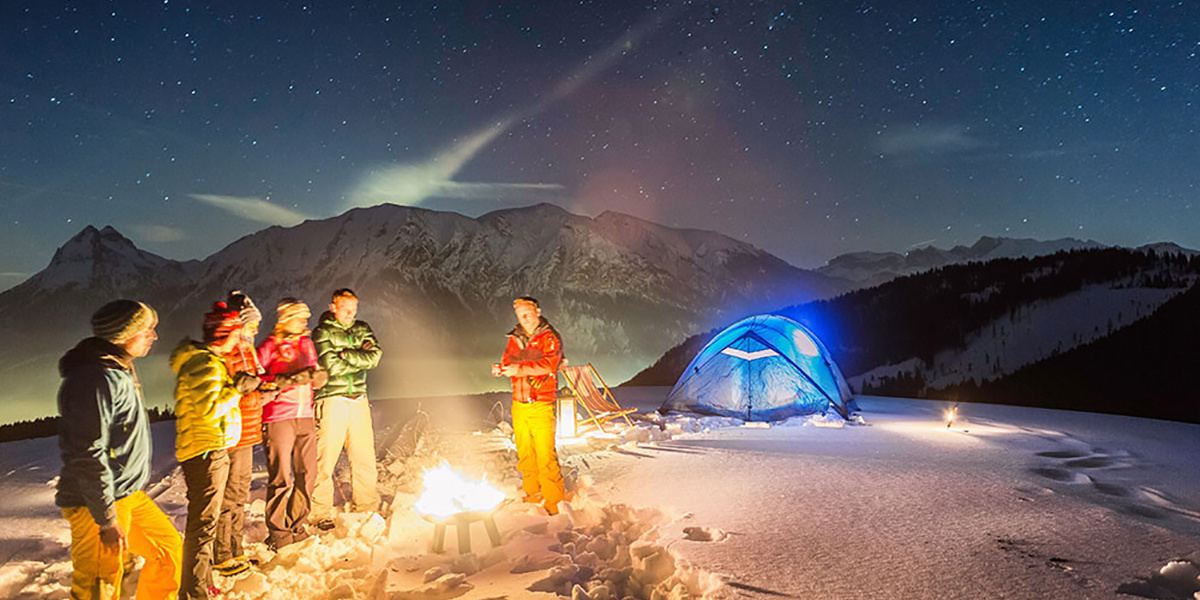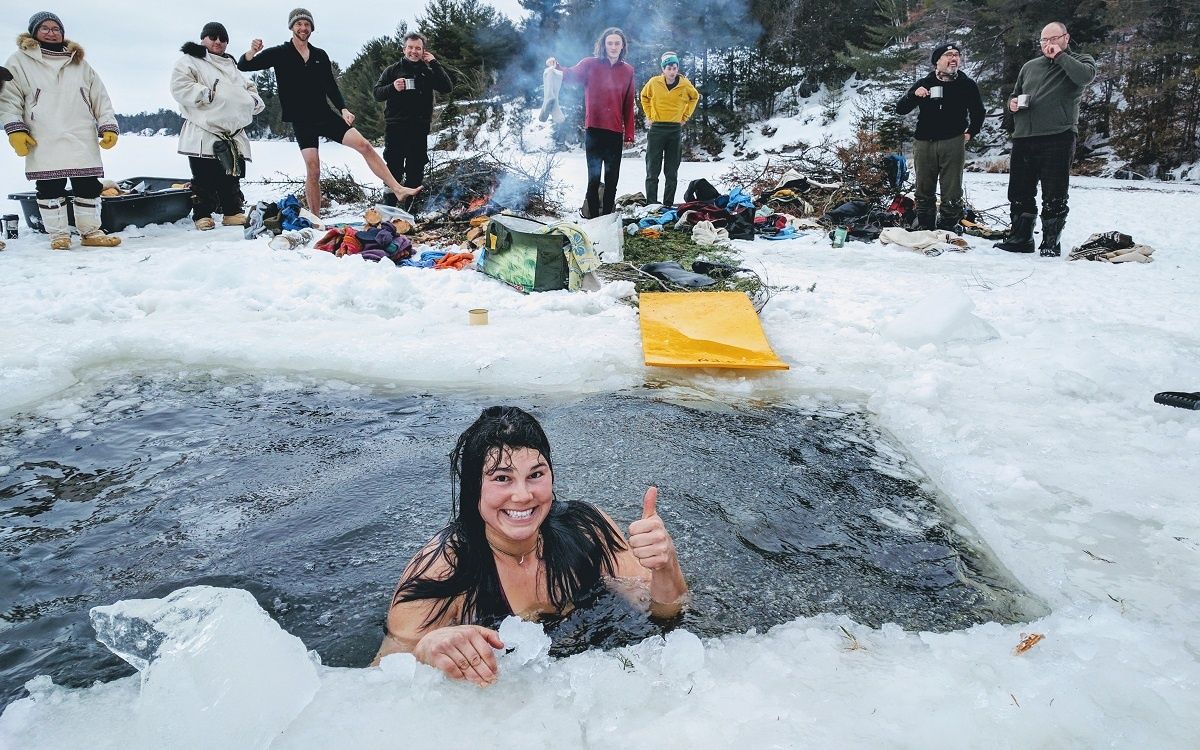

By Connor McGuigan
“What good is the warmth of summer, without the cold of winter to give it sweetness?” wrote John Steinbeck. Point taken, but there’s also a certain sweetness to the cold of winter. Cold-weather camping is a great way to savor those tranquil moments and settings only winter can provide—untouched snow-covered landscapes, early nights and early mornings, a warm fire—yet even some experienced campers balk at the prospect.
It’s easier than you may think to stay comfortable while winter camping. People prospered in frigid climates long before synthetic down and GoreTex, so you don’t necessarily need to break the bank at REI to stay warm and happy in winter conditions. On the other hand, you’ll be in serious trouble if you head out into the freeze underprepared. Check the weather forecasts and make sure your tent, sleeping bag and clothes can handle the conditions. It’s best to keep it simple on your first trip—stick to routes commonly traveled in the winter, and save that weeklong excursion for when you have more experience.
Here are 10 other tips to keep in mind as you prepare for your first trip. Many of these were sourced from Kevin Callan’s recently published Complete Guide to Winter Camping. Callan, a longtime outdoor enthusiast and author of 16 books, skillfully covers the basics of winter camping and showcases tips and tales from some of North America’s most accomplished winter campers. Check it out if you’re planning a trip and want to learn from the best.
1. Layer Up
The lynchpin to your winter camping getup is a close-fitting base layer to trap body heat. A pair of polypropylene long johns work great as a cheaper option. You’ll also want an insulating layer that you can take on and off as you warm up and cool down throughout the day. A down jacket, lightweight fleece or even your favorite wool sweater will do the job. Your outermost layer should protect you from wind, snow and rain, so choose a shell with weather-proof lining like GoreTex.
Avoid cotton altogether when packing for your trip—it’s no good at wicking moisture, and once it’s wet it can cool you faster than standing naked in the cold.
2. Stay Dry
That brings us to a second winter camping maxim: Stay dry. Water conducts heat better than air does, so wet clothes will quickly lower your body temperature. Even working up a sweat can dangerously cool you down in the long run. Take it slow and peel off layers to limit perspiration.
Wet feet mean frozen feet, so leave the trail runners at home. Waterproof boots and gaiters (along with snowshoes) are a must when trudging through deeper snow. If you’ll be hiking on top of packed snow, your normal hiking boots with some waterproofing treatment should be fine.
In general, it’s better to overpack than to run out of dry clothes—you’ll probably regret packing ultra-light when you slide on that pair of damp socks in the morning.
Don’t Try This.Dave Marrone / Lure of the North
3. Sleep With Your Gear
If you have any wet clothes by day’s end, keep them in your sleeping bag to dry them out overnight. You’ll also want to cozy up to any gadgets you brought, as cold temperatures quickly drain battery life.
4. Cowboy Coffee
If fireside nights are the highlight of any winter camping trip, cold mornings are the hardest part. The promise of hot coffee will make getting out of your sleeping bag a whole lot easier. All you need for a batch of “cowboy coffee” are grounds and hot water. Bring a pot of water to a rolling boil, move it from the heat source, dump in one tablespoon of coffee grounds per cup of water, and let it steep for 10 minutes. The simplest way to settle the grounds is to tap the coffee pot with a knife a few times. If you’re feeling up to it, try the classic but riskier method of swinging the coffee pot in a windmill motion a few times to settle the grounds with centripetal force. Once you’re done, pour yourself the most well-deserved cup of coffee you’ve ever had.
5. Strategic Urination
Experienced winter campers seem to stress this one. Drink plenty of water, but don’t idle when nature comes calling—your body will burn up valuable calories to heat any urine stored in your bladder. Keep an extra bottle in the tent (unmarked at your own peril) so you don’t have to venture into the cold for a midnight pee. Backpacker magazine compiled a list of products that make this winter camping ritual easier for women.
6. Choose the Right Sleeping Bag
First see if you can make do with what you have. You can avoid shelling out for a brand-new cold weather bag by buying a sleeping-bag liner, which can extend the temperature rating of your sleeping bag by 10 to 15 degrees. If the forecasted lows are way out of your sleeping bag’s range, you’ll want to invest in a 0-degree or lower bag.
7. Don’t Forget the Pad
Sleeping pads aren’t just there for comfort—they keep you off the frozen ground, which saps away your body heat faster than the air outside. There are some expensive insulated inflatable sleeping pads out there, but the important part is staying off the ground, so choose something you can afford that does the job.
8. Choose Your Campsite Wisely
A lot goes into finding the right winter campsite. As usual, the guiding principle is shelter from the elements. Avoid the bottom of hills, where cold-air troughs form, and the tops of hills, which can be exposed to wind. Choose a flat site, and compress the snow where you plan to pitch your tent by walking around on it—packed snow insulates heat better than loose snow. Make sure the tent is well staked down, and pitch it with the door perpendicular to prevailing winds.
9. Bring a Book
Winter nights are long, so you’ll be logging quite a few hours in your sleeping bag. Bring a book to pass the time. Check out Sierra magazine’s list of last summer’s best eco-conscious reads for some ideas.
10. Pitch a Tent Inside Your Car
This is a great way to stay warm through the night if you plan on car camping in the winter. Rigging a tent inside a car with clothespins may seem a little harebrained, but I’ve tried it in below-freezing weather and found that it does the trick. The car provides some added insulation, so it’s worth a try if your camping gear can’t quite handle the weather outside.
Reposted with permission from our media associate SIERRA Magazine.

 233k
233k  41k
41k  Subscribe
Subscribe 
